new posts in all blogs
Viewing: Blog Posts Tagged with: handwriting, Most Recent at Top [Help]
Results 1 - 18 of 18
How to use this Page
You are viewing the most recent posts tagged with the words: handwriting in the JacketFlap blog reader. What is a tag? Think of a tag as a keyword or category label. Tags can both help you find posts on JacketFlap.com as well as provide an easy way for you to "remember" and classify posts for later recall. Try adding a tag yourself by clicking "Add a tag" below a post's header. Scroll down through the list of Recent Posts in the left column and click on a post title that sounds interesting. You can view all posts from a specific blog by clicking the Blog name in the right column, or you can click a 'More Posts from this Blog' link in any individual post.

By:
Melissa Wiley,
on 12/31/2015
Blog:
Here in the Bonny Glen
(
Login to Add to MyJacketFlap)
JacketFlap tags:
Art,
journals,
sketchbook,
fountain pens,
pens,
art journals,
Midori,
Handwriting,
Assorted and Sundry,
Paper & Desk,
papery days,
travelers notebook,
Add a tag
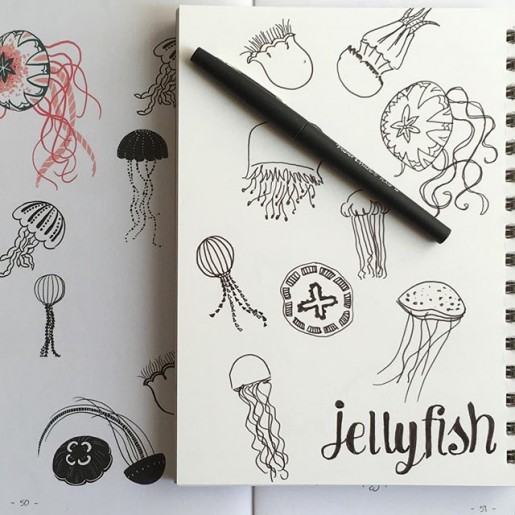
It started, I think, with my commitment to a daily sketching habit in the fall of 2014. By last January, the habit was firmly established, and I only missed a handful of days all year. January is also when I started taking “kourses” at Sketchbook Skool—which exposed me to not just the lessons and work of accomplished artists, but also to their media of choice. Which is to say: they have firm opinions about pens, making them my kind of people.
Putting pen to paper in my sketchbook reminded me how much I love that feeling. Now, I have never enjoyed doing large amounts of handwriting—I can’t write my books longhand, for example. My wrist aches after a couple of pages. But I love penmanship: other people’s, mainly. My handwriting is changeable and seldom neat. I never managed to commit to one way of shaping letters, so I wind up with different kinds of I and r and k all in one line. Last night I was numbering pages in a new bullet journal and realized that some of my 4s were the pointy kind and some were not. Happens all the time. I like change, y’all.

Anyway—I can’t write volumes by hand all at once, but I adore the feeling of a good pen on the right kind of paper. Experimenting with various pens (Pigma Micron, Le Pen, Pilot Metropolitan, Lamy Joy with 1.1 nib) reminded me how much I love analogue notetaking. So while I still find apps like Workflowy useful for tracking particular kinds of tasks, in the past few months I have shifted almost entirely to written notekeeping.
Notes on paper
Bullet journaling works very well for me. I’ve always kept a notebook as an idea and memory catch-all: phone call records, tasks completed, shopping lists, story ideas, doodles—it all winds up in the notebook in a giant jumble. Adding a bullet-journal-style index and page numbers was a revelation: now I can have my hodgepodge but find things later. Perfect.
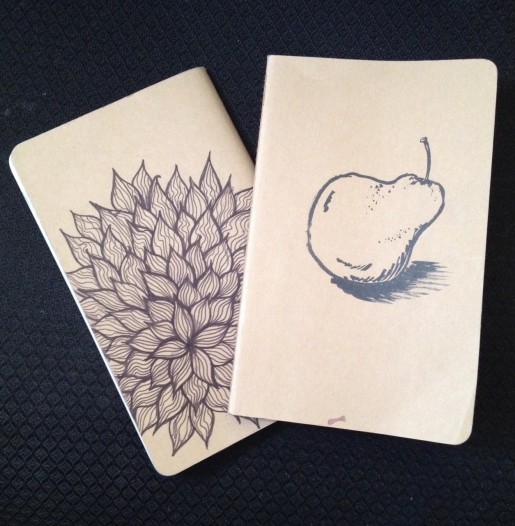
For the first part of this year I used kraft-brown Moleskine Cahiers. They’re just the right size for tucking in my bag, they’re sturdy enough to handle the beating I give them, and they fill up in a month or two which means the continual fresh start I love. Then, in August, a glorious friend surprised me with a Midori Traveler’s Notebook. It was love at first sniff. I mean, I. JUST. ADORE. THIS. THING.
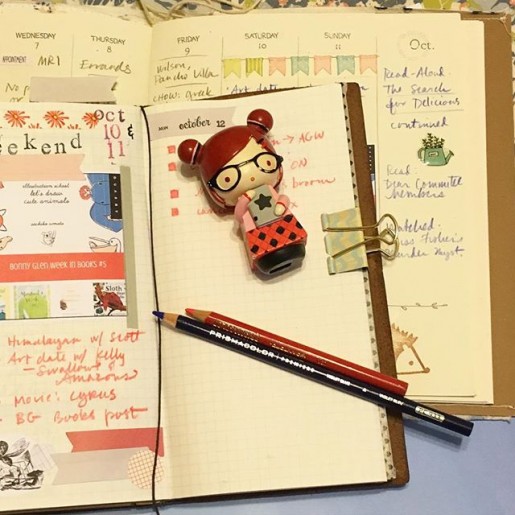
A traveler’s notebook, if you don’t know, involves a cover (usually leather, sometimes cloth or vinyl) that has a sturdy elastic cord or two strung through the spine. You slip a paper notebook under the cord to hold it in place. Then you can use additional bands to hold other inserts—various types of notebooks, folders, calendars, even plastic credit-card sleeves or zipper pouches.
My Midori set-up
After playing with my Midori for a month or two, I settled into the configuration that works best for me: a weekly calendar insert, a grid notebook, and a kraft folder that holds stickers, postage stamps, notepaper, and such. I keep a monthly calendar, too, but I don’t need to carry the whole year around with me so I have begun photocopying (and shrinking a bit) the current month and clipping that to my weekly page.
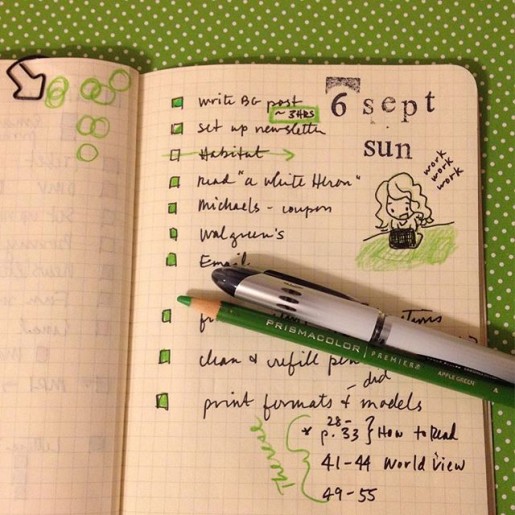
The blank grid insert is my bullet journal/idea repository/casual sketchbook, replacing the Moleskine Cahier. I number the pages and use the first page as an index, just as before. I like big fat checkboxes for my task lists, which I fill in with Prismacolor pencil as tasks are completed. Color is my happy place.  I also like to paste in ephemera and sometimes embellish with stamps, doodles, or washi tape. Basically, these inserts become collages of all the things that occupy my days and my mind. I seem to do a fair amount of sketching in them, too, even though I have an actual sketchbook for that purpose—I work in the real sketchbook daily but the TN grid insert is a low-pressure place to experiment, and I always have it with me.
I also like to paste in ephemera and sometimes embellish with stamps, doodles, or washi tape. Basically, these inserts become collages of all the things that occupy my days and my mind. I seem to do a fair amount of sketching in them, too, even though I have an actual sketchbook for that purpose—I work in the real sketchbook daily but the TN grid insert is a low-pressure place to experiment, and I always have it with me.
Thanks to Lesley Austin’s beautiful Wild Simplicity Daybook designs, I discovered that a week-on-two-pages spread is an excellent space for me to do some chronicling. I’ve posted before about how I use the Daybook for recording homeschooling and housekeeping notes. I really like having a separate space (and such a beautiful one) for those things. I wear so many hats, and I need ways to keep my roles sorted. The Daybook (visible under my Midori in a photo above), like all of Lesley’s paper goods, conveys a sense of peace and serenity, and so it has become a really nourishing space for me to jot down my notes about what the kids read, did, said. I always feel so happy when I open that book.
Taking a cue from that experience, I decided to try the Midori week-on-two-pages for my TN. The version I selected (Refill #19) has the week in seven horizontal boxes on the left page, and a grid page for notes on the right. I use Google Calendar for our family appointments and schedules, so a couple of times a week I open G-Cal and add any new appointments to the Midori insert. At the end of each day, I create an entry on the weekly calendar page, filling it with notes about what happened that day. It isn’t a to-do list, it’s more like a diary. Not what needs to be done (that’s what the bullet journal is for), but what I actually did. The facing page fills up with quotes, ephemera, drawings, and notes on things I’ve read or watched.
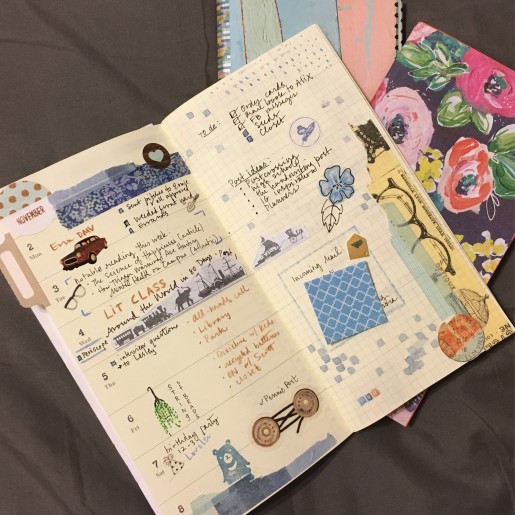
Since these pages serve as a kind of journal, I like to decorate them with washi, drawings, and watercolors. I wind up doing the ornamenting mostly on weekends. Often, I’ll start the week with two or three colors of washi in front of me, and that will set the tone for my week. This daily decorating is relaxing, it takes only moments, and I enjoy paging back through previous weeks.
So those are the two main TN inserts I carry around: the weekly calendar for journaling (more or less), and the grid notebook (Refill #2) for everything else. Those two inserts plus the kraft folder (Refill #20) make the Midori as fat as I like it to get. I could easily come up with uses for half a dozen more inserts (the TN’s capacity for letting you compartmentalize is its genius), but I found that I really prefer a non-chunky Midori.
However! I did decide to devote a single insert to all medical and health-insurance-related notes, and this has been one of my best moves ever. Instead of having those notes intermingled with everything else, they live in their own space now, with a list of phone numbers on the first page. I can tuck THAT insert into the Midori when we’re heading to an appointment. It’s perfect.
NEED MOAR PAPER
All this notebooking served to increase the satisfaction I was finding in putting pen to paper. And I found I was thinking about handwriting a lot. My little goddaughter sent me a thank-you note, and her mother’s handwriting on the envelope—the gorgeous, familiar handwriting that graced pages and pages of letters in the years after college when Krissy and I wrote to each other constantly—gave me a little jolt of joy and nostalgia. I hadn’t seen her writing in a while, and I missed it. I told her (via text, naturally) how happy I’d been to see her writing, and she said the same thing had happened to her when she saw my writing on the package I’d sent her daughter.
Shortly after that, I read that Atlantic article that was making the rounds about how the ballpoint pen killed cursive. Fascinating stuff, but the bit that grabbed me was this: “In his history of handwriting, The Missing Ink, the author Philip Hensher recalls the moment he realized that he had no idea what his good friend’s handwriting looked like. ‘It never struck me as strange before… We could have gone on like this forever, hardly noticing that we had no need of handwriting anymore.'”
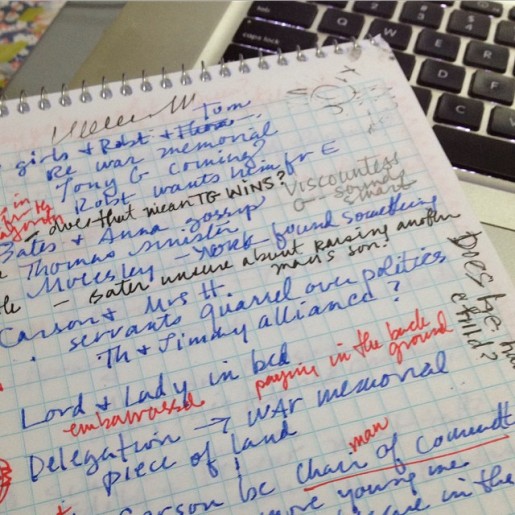
He had no idea what his good friend’s handwriting looked like. I miss handwriting, I thought. The distinct and beloved scripts of my old friends flashed before my eyes. I’d know those hands anywhere, could pick them out of any penmanship lineup. My kids probably won’t experience that. Jane has friends on the other side of the country she talks to via electronic means every single day, but they probably don’t know each other’s handwriting. I have plenty of friends myself whose writing I’ve never seen. If we met after 1995, chances are I’ve seen your handwriting seldom or never. (Tanita! What’s your writing like?)
Channeling my inner Jane Austen
The handwriting epiphany spurred me to the next phase of my analogue journey: I started writing letters again. Like, by hand. I have penpals in Denmark, France, Austria, and England, as well as various friends across the U.S.
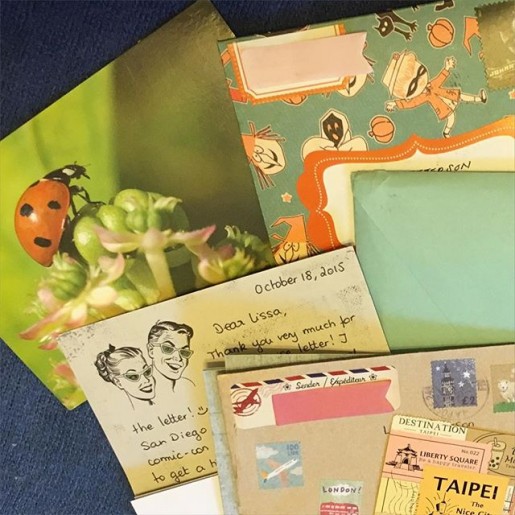
I’m amused and a little baffled that for so many years I thought of letters owing replies as a kind of guilt-ridden chore—I always took forever to answer, always had them nagging in the back of my mind. Because the truth is: snail mail is the cheapest fun around. Sure, they’re slower to write than email; slower to arrive than a Facebook message. But that’s part of the charm: the slowing down, the taking time. Just as many of us have (re)discovered the joys of slow reading in the past couple of years, I have found satisfaction in…what to call it? Not slow writing, really, because part of the point is that instead of waiting months or even (gulp) years to answer a letter, I now try to reply within three weeks; I guess what I’m enjoying isn’t about speed (or lack of it) after all. It’s about a tactile experience. The skritch of a fountain pen on flecked paper. The careful selection of stamps. The smoothing-out of a bit of washi tape across a seal. The rustle of envelopes as they slide into the box, slumbering before their journey to places I’ll never go.
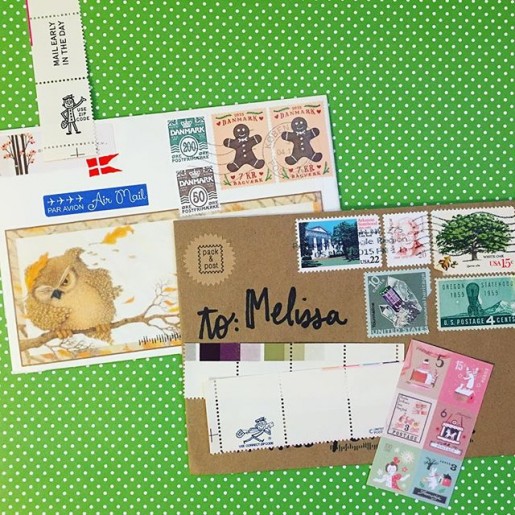
And best of all: the incoming letters. Foreign stamps, unfamiliar scripts, universal experiences. Beautifully decorated, many of them—it’s like getting mail from Griffin and Sabine. This one written at a café in Vienna; that one at a Starbucks in Portland. Kaleidoscopic glimpses of a life gradually resolving into a picture. We talk about things we could easily tell via email, but we’ve decided to let these stories take the scenic route. Some of them never arrive, or show up months later, ragged and stained. This only makes us love them more.
I’m writing to say I’ll write soon
A piece of the experience that affords me much merriment is the impulse, whenever a letter arrives, to hurry to Facebook and ping the friend who sent it. “Got your letter! Will reply soon,” I’ll write, and “Yay, can’t wait!” she’ll ping back. Never mind that the letter asks questions which could be more immediately answered via any of a dozen digital platforms. The answers will keep. Come Saturday afternoon, I’ll settle in with my cocoa, my envelopes, my wonderful new pink Lamy Safari that I got for my birthday. Which paper—the whimsical or the lovely? The fern stamps, or the Ingrid Bergmans? I’m almost out of globals, and the post office won’t have the new ones for a while. But have you seen them, the moons? I’m already imagining them on dark blue envelopes…
Our digital and analogue worlds will forever be intertwined, I believe. We’ll snap photos of our beautiful incoming mail to share on Instagram, hashtagged so our kindred spirits can find and enjoy it. We’ll trade addresses on Facebook. We’ll email to find out if that letter ever arrived. We’ll scour Etsy for traveler’s notebook inserts and stock up on ink at Goulet Pens. We’ll sign up for swaps on websites, and then anxiously check tracking to see when packages might arrive. We’ll reblog Tumblr articles about clever ways to hack a bullet journal. We’ll watch Youtube videos about how to set up a Midori and we’ll tap the heart button a zillion times during an unboxing on Periscope. We’ll link to photos of new USPS stamp releases in our blog posts. 
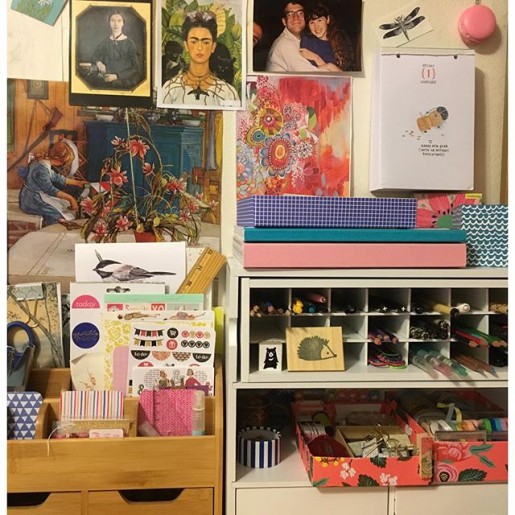
My blog, though, is perhaps the thing that suffered this past year as my attention shifted to paper and ink. I found that when I had a few quiet moments, I was more apt to want to spend them sketching or writing a letter than blogging. After ten years of a steady blog habit, that was a bit of a surprise. In January, this blog will be eleven years old. I’ve successfully figured out how to integrate my analogue and digital calendar-keeping and task-tracking, but it did take a little while for the pieces to settle into place. I expect the same will happen with blogging.
Happy New Year, friends!

By: Kathleen Neagle Sokolowski,
on 10/29/2015
Blog:
TWO WRITING TEACHERS
(
Login to Add to MyJacketFlap)
JacketFlap tags:
Lester Laminack,
SeeSaw,
conventions,
challenges,
Ralph Fletcher,
mentor texts,
writing workshop,
back to school,
parent involvement,
demonstration,
engagement,
personal narrative,
Lester L. Laminack,
katie wood ray,
handwriting,
Add a tag
Last Thursday, I endeavored to explain writing workshop to parents in my district at Parent University. As I drove home after the presentation, I felt unsettled, like there had been a gap in what the parents were hoping to learn and what I delivered. What would you be sure to include in a presentation to parents on writing workshop?

By:
Melissa Wiley,
on 6/9/2015
Blog:
Here in the Bonny Glen
(
Login to Add to MyJacketFlap)
JacketFlap tags:
dip pens,
sketchbook skool,
Jonathan Twingley,
steel brush pen,
Art,
Fun Learning Stuff,
fountain pens,
Handwriting,
Huck,
Add a tag
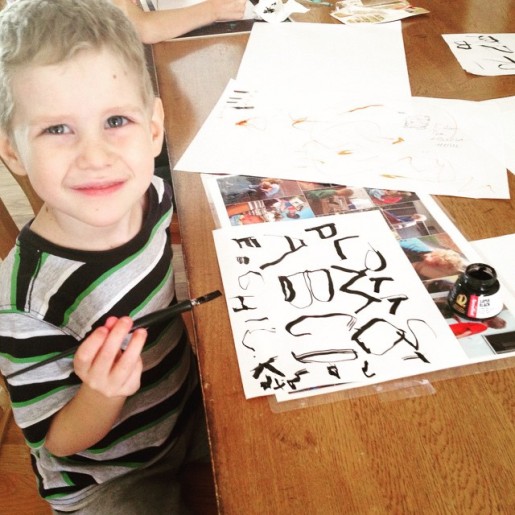
About once a week I bring my fountain pens to the kitchen tape for refilling. My reason for making this rather quick, benign chore a public affair is to take advantage of the great parenting truism: If you do it, they will copy. Huck isn’t the kind of kid who would be too keen on formal handwriting practice (does that kind of kid even exist?), but if I get busy with some nifty writing utensil, he’s at my side in a flash, begging for a turn.
Fountain pens are awesome enough, but dip pens? There’s nothing better. A bottle of ink, a nib with just the right amount of skritch…there’s a happy kid. I didn’t suggest the alphabet practice; he filled up the page as he chose.
That’s my beloved metal brush pen he’s holding, the $1.49 treasure acquired during my surprise trip to the art supply store on Mother’s Day. (The plastic Speedball pen holder was another buck fifty. We live large.)
(That’s an Amazon link to show you what it looks like, but as you can see, you’re much better off buying local for this one. That’s some markup, eh?)
I tumbled to the metal brush pen (aka my new best friend) in Jonathan Twingley’s rather amazing class at Sketchbook Skool. It was swoon at first site. You get a broad line from the flat nib, or you can turn it on its side for a fine line. It’s on the messy side—likes to spatter ink if you change direction midstroke—but for me that’s part of the appeal. I use it when I’m in the mood for rough, bold lines and a bit of ink spray. Jonathan Twingley likes to fill pages and pages with large drawings and then cut out selected images and collage them together into a new piece of art—really quite magical to behold him at work.
And this post offers a quite detailed look at what a steel brush nib can do.
We also have a pair of glass dip pens that my parents gave me years ago with more typical pointed nibs. You can see Huck’s page of orange squiggles on the table. I know somewhere in my archives I’ve talked about the magical powers of colored chalk and a little slate, or a whiteboard and dry erase markers, for transforming otherwise dull writing into fun. Dip pens are the same principle times a hundred.

Title: Google Handwriting
Cost: Free
Platform: Android (4.0.3 or later)
Google Handwriting is an app that works as an alternate keyboard to give Android users access to data wells through your scribbles.
Apps like Penultimate and Evernote have long enable handwriting input for searching content, but Google is a more "full-featured" handwriting-to-digital-text tool.
The really exceptional thing about Google Handwriting is how exponentially more accurate the writing-to-text translations manage to be, however sketchy the writing, as demonstrated below:
Google Handwriting
Part of the reason for the prediction quality: Google's optical text recognition has fine-tuned through Google Book project. Predictably, you can add your feedback on the accuracy of the handwriting translation to their database, but the default leaves this in-app reporting off.
You can double-tap any datawell to activate the handwriting input. As you write, your words are translated dynamically into a field just above, with three predictions to choose between, in a continuous ribbon. A green arrow serves to "enter" your input, or your can touch to toggle between fields. The handwriting input option works especially well when paired with Google Keep, which provides an ample space to jot.
And Google Handwriting perhaps most intriguingly, allows you to draw emojis, predicated on your familiarity with emojis.
I can see Google Handwriting being of real utility for those with Samsung Note phablets as well as for those who never learned their QWERTY keys. But even for touch typists, it's good to experience the web through another input and, like playing around with voice control, provides a way to experience web searching and navigation from a different perspective.
Check out more great Apps in our App of the Week archive. Have an idea for an App you'd like us to spotlight? Let us know.

Linda Shrewsbury has raised more than $28,000 for the CursiveLogic workbook.
It has been a trend as of late for educators to eliminate cursive handwriting from their school curiculums. Shrewsbury hopes to address this issue with this book. The money from this campaign will be used to cover the costs of development and printing. We’ve embedded a video about the project above.
Here’s more from the Kickstarter page: “Cursive handwriting is becoming a lost art. With the near universal use of word processing and ever-increasing pressures on classroom time, many schools have removed cursive from the curriculum. Why, they ask, should students learn to write in cursive in the age of tablets and iPhones? While electronic devices have added an element of convenience to the writing process, evidence is mounting that putting pen to paper has benefits that typing cannot replace.”
Welcome to our Kickstarter Publishing Project of the Week, a feature exploring how authors and publishers are using the fundraising site to raise money for book projects. If you want to start your own project, check out How To Use Kickstarter to Fund Your Publishing Project.
We spend lots of time talking about the writing process here at TWT. This post tackles something that has nothing to do with meaning, structure, focus, word choice, elaboration, voice, or conventions. It deals with the physical act of writing, which can be challenging for some children.
Long, long time ago and in a galaxy far, far away, it was the time before computers. Even typewriters were not a common household item. At least, not in my childhood home on the front range of Colorado. Colorado Springs was small then, full of open spaces. The public library was way, way on the other side of town. There were no bookstores. The only library available to me was my school library. I checked out every book I could read. By fourth grade, my favorite authors were already Mark Twain, Jack London, Charles Dickens, James Fennimore Cooper, Tolkien’s The Hobbit, and many more. And if I wanted to have my very own copy of a book, so I didn’t have to return it, I copied the book.
By hand.
So is it a wonder that I became a writer when I grew up?
Even now, after all these decades, with the onslaught of computers, iPads and fancy programs that write text for you, I still write everything by hand. Even this article was first written by hand.
It turns out to be a good thing, to write by hand. Scientists now know that cursive writing is an important tool for cognitive development. It teaches the brain to be efficient, helps to develop critical thinking skills and refines motor control. In fact, children who learn cursive tend to learn how to read faster, generate more ideas and retain more information.
When I was copying my books in the fourth grade, I paid more attention to the details of the story. I experienced the characters on a deeper level because the very act of writing them out engaged all my senses. I had to pay attention to the words, how they were ordered, and how they were used. And, of course, I experienced the linear logic of the plot.
When I grew up, I began writing stories that featured the landscape and characters that were larger than life. A student of American history and folklore, my first books were picturebooks. If you want to know more about my picturebooks, check out JoAnn’s interview with me here!


I continued exploring the American landscape, blending folklore and history in my first middle grade novel,
Big River’s Daughter (Holiday House, 2013). The book comes recommended by the International Reading Association, and was nominated for the Amelia Bloomer Project (American Library Association, 2013). The book is listed on A Mighty Girl’s Top 2013 Mighty Girl Books for Tweens and Teens. My second middle grade historical fiction is
Girls of Gettysburg (Holiday House 2014) and takes on the daunting challenge of researching the Battle of Gettysburg. For this story, I walked the battlefields four times, experiencing the very landscape where my characters lived and breathed, and died. If you are interesting in my research process for this book, you might enjoy this interview by Laurie J. Edwards,
here. The book comes recommended by Booklist as “a unique, exciting work.” School Library Journal calls the book a “riveting historical fiction.” The book is listed as a Hot Pick on Children’s Book Council for September 2014.
Of course, writers have to pay the bills. While I never planned to be a teacher, it seemed a natural fit. I teach college freshman and older students. Of course, now all the students use computers to read texts and compose their essays. And iPads, and even their phones. Most of them are proud to proclaim they have never used a pen or pencil. I make them print out the research and drafts, and have them write out their annotations and corrections on the paper. I make them experience the words and the organization in order to determine how everything fits together. They don’t always appreciate the experience. But their essays are usually better for it.
As Julia Cameron once said, “When we write by hand, we connect to ourselves. We may get speed and distance when we type, but we get a truer connection – to ourselves and our deepest thoughts – when we actually put pen to page.”
You might be interested to see more:
“
Why Writing by Hand Could Make You Smarter”, by William Klemm. Psychology Today. March 14, 2013.
Julia Cameron Live, "
Morning Pages: why by hand?. The Artist’s Way." October 4, 2012
Bobbi Miller
 |
| Image from Morguefile |

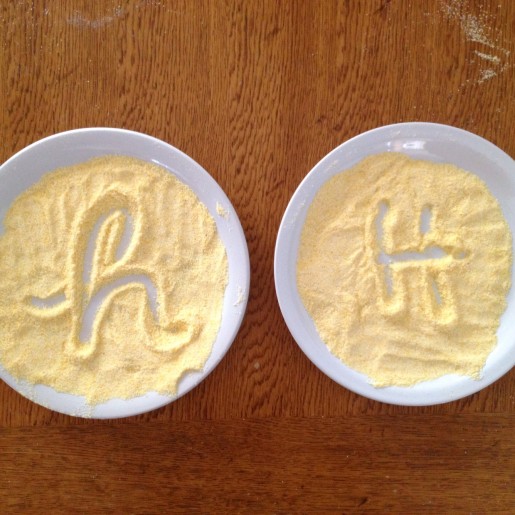
Today I forgot to blog first; it’s nearly bedtime. 
Melanie has begun a link-up for sharing daily learning notes, always an engaging topic (if you’re anything like me). I used to have an entire side-blog for my daily notes, and then a different one, and then a different one. These days I’m tracking things on paper, but I do like to compile some of our best resources and rabbit trails here pretty often, as you know.
Selvi asked in the comments the other day why we were working on memorizing the English monarchs, because I’ve mentioned that several times. The main reason, as I replied to her, is because they make very handy pegs for hanging other historical events on. So often in our history, literature, and science reading we come across some incident involving Great Britain and we used to always say, “Who was king then? Or was it queen?” So we set about learning the list (and American presidents as well, but that was easier because these kids grew up on the Singin’ Smart CD with its infectious tune for the presidents) and it turned into a really fun family accomplishment. Oh the triumph now when we can all get through the Horrible Histories song without a hitch! 
Our various readings continue to interconnect in satisfying ways. We spent a couple of weeks on Wordsworth (you don’t leave this house until you know a good bit about the Romantics, that’s just the way it is) and are reading Coleridge this week, and that has created excellent crossover with our readings about the French Revolution. Except a MOST UNFORTUNATE THING happened and that is: while (continuing on in the juggernaut of world history) reading aloud about Napoleon, my tongue got twisted and his name came out BonaFART. Never, never, never shall I be allowed to live this down. Never, never, never shall I be permitted to read another word about him without a ripple of giggles across the room. Waterloo can’t come fast enough, believe me. I might have to move to Elba myself.
ANYWAY, back to Coleridge. We began a discussion of “Frost at Midnight” today, which is one of my most beloved poems. It’s a good many years since I’ve lived where there’s frost, but I still look at a winter sky and inhale the cold air and think of silent icicles quietly shining to the quiet moon. We found so much to discuss in the first stanza that that’s as far as we got for now—and the best is yet to come.
Today during our after-lunch block (that’s when I focus my attention on Huck and Rilla), we did cornmeal letters. Uppercase printing for Huck and lowercase cursive for Rilla. This was a new activity for Huck and he enjoyed it tremendously. (And ate a whole lot of dry cornmeal, gah.) He’s not yet shown much interest in writing or drawing—loves to paint big swirls and stripes of color, but crayons interest him not at all—but we have a Montessori Letter Shapes app that mimics this kind of tactile finger-tracing, and he used to play that quite a lot. When I put the plate of cornmeal in front of him today and showed him what we were going to do, he asked, politely puzzled, “But how do we reset it?” No reset button, you see. Oh my digital-era child.
He got the hang of the analog method pretty quick. 
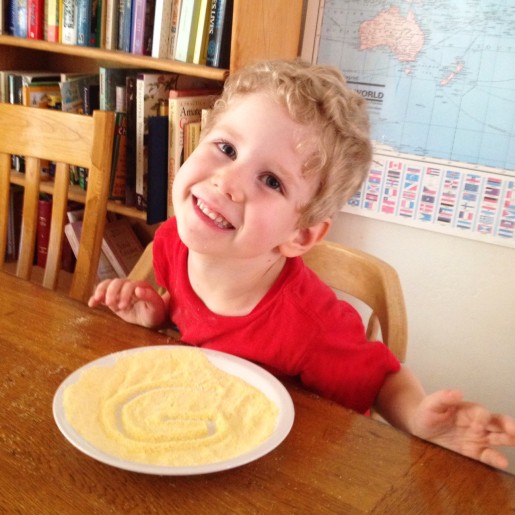
G is for grin

By:
Carmela Martino and 5 other authors,
on 8/22/2014
Blog:
Teaching Authors
(
Login to Add to MyJacketFlap)
JacketFlap tags:
writing longhand,
Poetry,
Poetry Friday,
poem,
Book Giveaway,
children's poems,
handwriting,
Irene Latham,
April Halprin Wayland,
Add a tag
.
Howdy, Campers and Happy Poetry Friday!
We
TeachingAuthors are discussing handwriting versus keyboard typing--read which
Carmela,
Laura, and
Esther prefer.
Me? I'm bi.
When I'm in a boring meeting (or even an interesting meeting), under the hair dryer at the beauty parlor, or the passenger on a long trip, I'm happy to write poems in my little notebooks with my
favorite pen.
.
But I became a writer as on one of these:
and my brain and fingers still adore keys.
So I wrote two poems today in honor of both:
TYPING
by April Halprin Wayland
It’s a sound idea—a muscular,a strong one.
It’s strapping, able-bodied oneit’s beefy—it’s a long one.
It’s a strapping noun,it’s her fingers plunked downwith a most decisive click.
It’s a piece of punctuationthat’s sealed—it sticks.
LONGHAND.by April Halprin Wayland
liquid longhand sometimes flowsor oozes slowit drains from a dream to its place on the page
where it will not linger no, the pen seeps deeperbeneath each linewhere longhand makes its own design
poems (c) 2014 April Halprin Wayland. All rights reserved.
And if you haven't already done so, don't forget to enter our current giveaway for a chance to win the historical middle-grade novel Odin's Promise (Crispin Press) by Sandy Brehl. See JoAnn's post for all the details.(We're supposed to sign our names at the bottom of each post...so hi, it's me--April Halprin Wayland! G'bye!)

Hi folks, it is getting crazy hot here. Over a 100. Whew! Welcome to my little corner of the interwebs.
Did you know that PLUMB CRAZY is coming out in paperback? I'm celebrating! Enter to win the Plumb Crazy Book and Boots Giveaway. Book and $100 Gift Card to Cavenders:.tinyurl.com/mv2ku8y.
This week I offer a gem to help you with the creative process. I can't do all my work on the computer, Handwriting plays an important part in my creative process. I have to write the things by hand and don't expect something linear and neat. Expect bubbles with ideas, doodles of flowers and geometric shapes, half finished lists, freewrites, graphs, charts, me grousing about how hard it is to write books, pages of lame ideas, and lists of marketing ideas too.
I can't think any of this stuff on the computer, but I can think it on paper. I believe all this stuff happens in handwriting because I am bringing my style and individuality to the shape of the words. This added dimension opens wellsprings within. If you are struggling with moving forward with a creative project, grab a sheet of paper and a pen you really like and pour out your thoughts! You might be surprised.
I will continue this month with gems of creative wisdom. My doodle and quote are at the end. First a recap of the book tour!
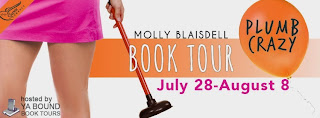
Plumb Crazy Book Tour Recap!
Fun stuff
The PLUMB CRAZY playlist - Victoria Simcox's Blog - http://ow.ly/zSdHS
You can listen to it on Youtube - http://ow.ly/zSdHS!
The Plumb Crazy Dream Cast! -The Avid Reader - http://ow.ly/zSgpj
Mitch's Profile! -- Book Club Sisters - http://ow.ly/zSf99
Mitch wins Book Boyfriend of the Week! - Book Boyfriend Reviews - http://ow.ly/zShqN
Wherein I Interview my character Mitch! - The Written Adventure - http://ow.ly/zSfS2
Author Interview! -- Kelly P's Blog - http://ow.ly/zSeo9
Wherein I share a true writer's journey - Writers' Connection - http://ow.ly/zSg7q
My Five Favorite Movies - My Love for Reading Keeps Growing - http://ow.ly/A8VxH
Tour Reviews
***** Review - Books Are Love -- http://ow.ly/A8YCc and http://ow.ly/A8Z0B
A quote for your pocket:
Life is short. Art long. Opportunity is fleeting. Experience treacherous. Judgement difficult. Geoffrey Chaucer (The Assembly of Fowles, line 1)
A few days ago, I
wrote here of what is gained when we, mid-course into a new book, return to its beginning. How, when we dwell with what has already been written, when we don't rush toward the climax, the close, the
I'm done!, we discover the true heart of the story. We find all that will propel us to a meaningful end.
Plus, it's really fun.
Today, again, I offer simple advice, on the theory that it's the simple stuff that we tend to overlook when we find ourselves in the heat of writerly angst.
That advice: Take out a pen. Take out a notebook. Write the story by hand.
There are a few reasons for this. One, obviously, away from the computer, you are, hopefully, away from the tempting distractions that electronically creep in. But even more importantly, as
this Maria Konnikova story in the New York Times suggests, writing something down, using our own hands, pressing into the page beneath us, does something to our brains. It activates neural networks that are key to the making of stories:
The effect goes well beyond letter recognition. In a study that followed children in grades two through five, Virginia Berninger, a psychologist at the University of Washington, demonstrated that printing, cursive writing, and typing on a keyboard are all associated with distinct and separate brain patterns — and each results in a distinct end product. When the children composed text by hand, they not only consistently produced more words more quickly than they did on a keyboard, but expressed more ideas. And brain imaging in the oldest subjects suggested that the connection between writing and idea generation went even further. When these children were asked to come up with ideas for a composition, the ones with better handwriting exhibited greater neural activation in areas associated with working memory — and increased overall activation in the reading and writing networks.
I always write by hand. The first draft of everything is a mess of ink on scattered journals. It is my head working, my hand trailing behind, nothing much, until it becomes something very much. I'll sneak back the computer when I have a few pages. I'll type a vague resemblance of the handwritten material there—clean it up, straighten it, do some logic tests. But then, again, I print those computer pages and I'm back on the couch, scratching out most everything, writing in the margins. Back and forth, this is the process.
The best stuff—the best details, dialogue chains, discoveries—is always the result of a pen in hand.
And only after I've done this many times, do I share the work with my editor, Tamra Tuller. Our conversation about how we work after that is
here.

Photo and notes by Vicky Lorencen
“Handwritten letters are more special. They’re heartfelt,” my teen daughter said. “They aren’t like texts. You want to read them over and over.”
Such a brilliant girl. [Mom blushes.] She recognizes the power of the written word–the handwritten word.
Eons ago I sent letters to a friend during a dark time in her life. But, to be honest, I had forgotten all about them until I received a surprise in the mail last week. My friend wrote to tell me, “Your loving, tender words were part of the life-saving medicine that kept me alive until I felt like living again.” Wow. I was clueless to the impact of my letters. Incapable of mending her broken heart or fixing her circumstances, all I had to offer were words. And so I did.
Inside her letter, wrapped in a pink ribbon, my friend tucked some of the more the two dozen letters she’d received from me and kept all these years. (See photo.) She said she wanted to return my words to me. How unexpected and exceptional! Re-reading those letters I’d penned ages ago made me grateful to know I was able to do something for a friend in need.
Words are free. Most anyone can draft a sentence. But it takes a willing writer to string those words into something meaningful and soul-touching. You have that ability. It’s a power of incomparable worth.
Whose life will be better because they received a word from you?
Take 20 minutes right now–less time than it takes to watch a sitcom–and write a letter to someone. Don’t fret over revising, critiquing, scrutinizing and all that jazz. Just let your heartfelt words flow. Then address that note, stick on a stamp and send it on its way.
Do it. Don’t delay. Exercise your power today.
To write is human, to receive a letter: Divine! ~ Susan Lendroth


Enter to win a Little Red Writing prize pack.
Giveaway begins September 15, 2013, at 12:01 A.M. PST and ends October 13, 2013, at 11:59 P.M. PST.

By: Alice,
on 9/9/2013
Blog:
OUPblog
(
Login to Add to MyJacketFlap)
JacketFlap tags:
Editor's Picks,
*Featured,
Physics & Chemistry,
Science & Medicine,
ciphers,
James O’Brien,
Scientific Sherlock Holmes,
typewritten documents,
Literature,
dogs,
Edgar Allan Poe,
sherlock holmes,
holmes,
fingerprints,
footprints,
handwriting,
arthur conan doyle,
forensic science,
sherlock,
Add a tag
By James O’Brien
Between Edgar Allan Poe’s invention of the detective story with The Murders in the Rue Morgue in 1841 and Sir Arthur Conan Doyle’s first Sherlock Holmes story A Study in Scarlet in 1887, chance and coincidence played a large part in crime fiction. Nevertheless, Conan Doyle resolved that his detective would solve his cases using reason. He modeled Holmes on Poe’s Dupin and made Sherlock Holmes a man of science and an innovator of forensic methods. Holmes is so much at the forefront of detection that he has authored several monographs on crime-solving techniques. In most cases the well-read Conan Doyle has Holmes use methods years before the official police forces in both Britain and America get around to them. The result was 60 stories in which logic, deduction, and science dominate the scene.
FINGERPRINTS
Sherlock Holmes was quick to realize the value of fingerprint evidence. The first case in which fingerprints are mentioned is The Sign of Four, published in 1890, and he’s still using them 36 years later in the 55th story, The Three Gables (1926). Scotland Yard did not begin to use fingerprints until 1901.
It is interesting to note that Conan Doyle chose to have Holmes use fingerprints but not bertillonage (also called anthropometry), the system of identification by measuring twelve characteristics of the body. That system was originated by Alphonse Bertillon in Paris. The two methods competed for forensic ascendancy for many years. The astute Conan Doyle picked the eventual winner.
TYPEWRITTEN DOCUMENTS
As the author of a monograph entitled “The Typewriter and its Relation to Crime,” Holmes was of course an innovator in the analysis of typewritten documents. In the one case involving a typewriter, A Case of Identity (1891), only Holmes realized the importance of the fact that all the letters received by Mary Sutherland from Hosmer Angel were typewritten — even his name is typed and no signature is applied. This observation leads Holmes to the culprit. By obtaining a typewritten note from his suspect, Holmes brilliantly analyses the idiosyncrasies of the man’s typewriter. In the United States, the Federal Bureau of Investigation (FBI) started a Document Section soon after its crime lab opened in 1932. Holmes’s work preceded this by forty years.
HANDWRITING
Conan Doyle, a true believer in handwriting analysis, exaggerates Holmes’s abilities to interpret documents. Holmes is able to tell gender, make deductions about the character of the writer, and even compare two samples of writing and deduce whether the persons are related. This is another area where Holmes has written a monograph (on the dating of documents). Handwritten documents figure in nine stories. In The Reigate Squires, Holmes observes that two related people wrote the incriminating note jointly. This allows him to quickly deduce that the Cunninghams, father and son, are the guilty parties. In The Norwood Builder, Holmes can tell that Jonas Oldacre has written his will while riding on a train. Reasoning that no one would write such an important document on a train, Holmes is persuaded that the will is fraudulent. So immediately at the beginning of the case he is hot on the trail of the culprit.
FOOTPRINTS
Holmes also uses footprint analysis to identify culprits throughout his fictional career, from the very first story to the 57th story (The Lion’s Mane published in 1926). Fully 29 of the 60 stories include footprint evidence. The Boscombe Valley Mystery is solved almost entirely by footprint analysis. Holmes analyses footprints on quite a variety of surfaces: clay soil, snow, carpet, dust, mud, blood, ashes, and even a curtain. Yet another one of Sherlock Holmes’s monographs is on the topic (“The tracing of footsteps, with some remarks upon the uses of Plaster of Paris as a preserver of impresses”).

CIPHERS
Sherlock Holmes solves a variety of ciphers. In The “Gloria Scott” he deduces that in the message that frightens Old Trevor every third word is to be read. A similar system was used in the American Civil War. It was also how young listeners of the Captain Midnight radio show in the 1940s used their decoder rings to get information about upcoming programs. In The Valley of Fear Holmes has a man planted inside Professor Moriarty’s organization. When he receives an encoded message Holmes must first realize that the cipher uses a book. After deducing which book he is able to retrieve the message. This is exactly how Benedict Arnold sent information to the British about General George Washington’s troop movements. Holmes’s most successful use of cryptology occurs in The Dancing Men. His analysis of the stick figure men left as messages is done by frequency analysis, starting with “e” as the most common letter. Conan Doyle is again following Poe who earlier used the same idea in The Gold Bug (1843). Holmes’s monograph on cryptology analyses 160 separate ciphers.
DOGS
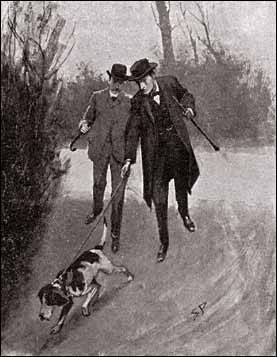 Conan Doyle provides us with an interesting array of dog stories and analyses. The most famous line in all the sixty stories, spoken by Inspector Gregory in Silver Blaze, is “The dog did nothing in the night-time.” When Holmes directs Gregory’s attention to “the curious incident of the dog in the night-time,” Gregory is puzzled by this enigmatic clue. Only Holmes seems to realize that the dog should have done something. Why did the dog make no noise when the horse, Silver Blaze, was led out of the stable in the dead of night? Inspector Gregory may be slow to catch on, but Sherlock Holmes is immediately suspicious of the horse’s trainer, John Straker. In Shoscombe Old Place we find exactly the opposite behavior by a dog. Lady Beatrice Falder’s dog snarled when he should not have. This time the dog doing something was the key to the solution. When Holmes took the dog near his mistress’s carriage, the dog knew that someone was impersonating his mistress. In two other cases Holmes employs dogs to follow the movements of people. In The Sign of Four, Toby initially fails to follow the odor of creosote to find Tonga, the pygmy from the Andaman Islands. In The Missing Three Quarter the dog Pompey successfully tracks Godfrey Staunton by the smell of aniseed. And of course, Holmes mentions yet another monograph on the use of dogs in detective work.
Conan Doyle provides us with an interesting array of dog stories and analyses. The most famous line in all the sixty stories, spoken by Inspector Gregory in Silver Blaze, is “The dog did nothing in the night-time.” When Holmes directs Gregory’s attention to “the curious incident of the dog in the night-time,” Gregory is puzzled by this enigmatic clue. Only Holmes seems to realize that the dog should have done something. Why did the dog make no noise when the horse, Silver Blaze, was led out of the stable in the dead of night? Inspector Gregory may be slow to catch on, but Sherlock Holmes is immediately suspicious of the horse’s trainer, John Straker. In Shoscombe Old Place we find exactly the opposite behavior by a dog. Lady Beatrice Falder’s dog snarled when he should not have. This time the dog doing something was the key to the solution. When Holmes took the dog near his mistress’s carriage, the dog knew that someone was impersonating his mistress. In two other cases Holmes employs dogs to follow the movements of people. In The Sign of Four, Toby initially fails to follow the odor of creosote to find Tonga, the pygmy from the Andaman Islands. In The Missing Three Quarter the dog Pompey successfully tracks Godfrey Staunton by the smell of aniseed. And of course, Holmes mentions yet another monograph on the use of dogs in detective work.
James O’Brien is the author of The Scientific Sherlock Holmes. He will be signing books at the OUP booth 524 at the American Chemical Society conference in Indiana on 9 September 2013 at 2:00 p.m. He is Distinguished Professor Emeritus at Missouri State University. A lifelong fan of Holmes, O’Brien presented his paper “What Kind of Chemist Was Sherlock Holmes” at the 1992 national American Chemical Society meeting, which resulted in an invitation to write a chapter on Holmes the chemist in the book Chemistry and Science Fiction. He has since given over 120 lectures on Holmes and science. Read his previous blog post “Sherlock Holmes knew chemistry.”
Subscribe to the OUPblog via email or RSS.
Subscribe to only science and medicine articles on the OUPblog via email or RSS.
Image credit: (1) From “The Adventure of the Dancing Men” Sherlock Holmes story. Public domain via Wikimedia Commons. (2) Sherlock Holmes in “The Adventure of the Missing Three-Quarter.” Illustration by Sidney Paget. Strand Magazine, 1904. Public domain via Wikimedia Commons.
The post Six methods of detection in Sherlock Holmes appeared first on OUPblog.

If you’re in an elementary school, you’ve inevitably had discussion with parents about handwriting. My policy for writer’s notebooks was always, “As long as I can read it, it’s neat enough.” I didn’t… Read More →

By: Lauren,
on 10/29/2010
Blog:
OUPblog
(
Login to Add to MyJacketFlap)
JacketFlap tags:
Blogs,
cows,
ghosts,
ikea,
esquire,
handwriting,
gizmodo,
foursquare,
linked up,
federal budget,
vegan,
rent,
mashable,
urlesque,
dominoes,
trendland,
Featured,
burger,
bravo,
Add a tag
[Insert witticism here.]
Book Dominoes FTW! [Urlesque]
This week in unnecessarily large versions of unhealthy foods… [Good]
Esquire thinks we can balance the federal budget in 3 days. Good luck with that one, guys. [Esquire]
Type in your own handwriting! [Pilot via GalleyCat]
If you didn’t already know, being vegan is hard. [Gizmodo]
A new blog of short essays. [BOTA]
Former OUPblogger “Johnny” in his Halloween costume… [Bravo TV]
Are you ready to be Super Duper/Epic on Foursquare??? [Mashable]
IKEA gets into the cookbook biz. [Trendland]
“51% of Americans would live with a ghost as long as rent were free, while 27% would share space with a spectre for a 50% reduction in rent.” [USA Today via The Awl]

One of the small problems about flying off next week to tell stories at Delhi's Bookaroo Children’s Book Festival(with surrounding holiday) is that . . . . er . . er . . . part of me quite wants to stay home here in Yorkshire working on Tome Two.
I’m behind on my personal deadline. This Autumn’s run of visits tore into the energy I need for my writing work. This is not a complaint, especially as the schools and libraries were really great, but the big fact in most author's writing/earning balance. Visiting is essentially “Out There”; Writing is “In Here”.
I know I should be up and at the Tome every spare second, but my creative mind doesn’t work like that, and before anyone quotes inspirational tales of Messrs Trollope or Archer or even the feted Miss Price, I have no servants, assistants or anyone else writing down my book words.
However, the enforced silence was useful. Returning to the Tome, I suddenly saw that a certain light and subtle story twist was actually constructed of a material somewhat heavier then lead. It required, and will require, strong and severe plot-wrangling.
There is also another problem to solve. The small matter of X, a secondary character: a pale, pitiful creature doomed to arrive at a poignantly early end.
X has decided to be nothing of the sort. In true Jasper-Ffordean manner, she is stomping on furiously, full of life and health and wanting to have her own way. Just now I can’t see how or if I can ever take her in hand, let alone what she will do to the main characters. So much for the power of the synopsis! She cannot be trusted alone.
So I have decided that in Delhi, home of the power-cut,I must keep writing, but it will be - aagh! - by hand. Even though that means facing up to my awful over-excited scrawl. Even though I need the protective “writing distance” my computer screen gives me. I considered the lap-top option, but that adds weight and safety issues. Hand-writing sounds so much more reliable, doesn’t it?
I fear it will all come back to me: the stained fingers, the gloom as the paper is covered in more and more deletions, the awful over-writing, the sense of homework badly done. Ho hum. I must try to be positive.
Will my back-to-scribbling plan work? It's essential that it does, because I’ve reached a significant point in the making of Tome Two, a moment that ABBA writers may recognise, and it is joyous. When I sat down to work this last week, the writing had begun speaking back to me.
www.pennydolan.com

YourFont is a free, web-based program that allows you to turn your handwriting into a font. Basically, all you have to do is:
- Download their PDF template
- Scribble out your alphabet
- Scan
- Upload
- Download the finished font
Oh, happy days. I’m gonna try this out as soon as I get a free hour.
via Lifehacker





 I also like to paste in ephemera and sometimes embellish with stamps, doodles, or washi tape. Basically, these inserts become collages of all the things that occupy my days and my mind. I seem to do a fair amount of sketching in them, too, even though I have an actual sketchbook for that purpose—I work in the real sketchbook daily but the TN grid insert is a low-pressure place to experiment, and I always have it with me.
I also like to paste in ephemera and sometimes embellish with stamps, doodles, or washi tape. Basically, these inserts become collages of all the things that occupy my days and my mind. I seem to do a fair amount of sketching in them, too, even though I have an actual sketchbook for that purpose—I work in the real sketchbook daily but the TN grid insert is a low-pressure place to experiment, and I always have it with me.
















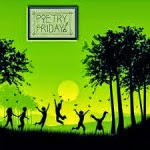
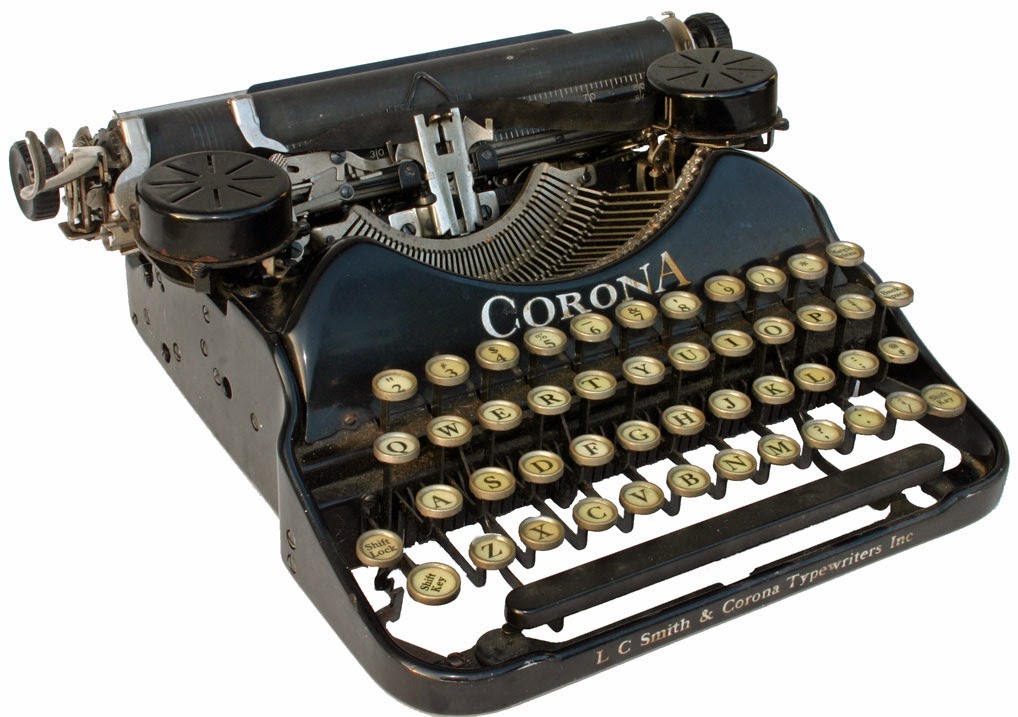




 Conan Doyle provides us with an interesting array of dog stories and analyses. The most famous line in all the sixty stories, spoken by Inspector Gregory in Silver Blaze, is “The dog did nothing in the night-time.” When Holmes directs Gregory’s attention to “the curious incident of the dog in the night-time,” Gregory is puzzled by this enigmatic clue. Only Holmes seems to realize that the dog should have done something. Why did the dog make no noise when the horse, Silver Blaze, was led out of the stable in the dead of night? Inspector Gregory may be slow to catch on, but Sherlock Holmes is immediately suspicious of the horse’s trainer, John Straker. In Shoscombe Old Place we find exactly the opposite behavior by a dog. Lady Beatrice Falder’s dog snarled when he should not have. This time the dog doing something was the key to the solution. When Holmes took the dog near his mistress’s carriage, the dog knew that someone was impersonating his mistress. In two other cases Holmes employs dogs to follow the movements of people. In The Sign of Four, Toby initially fails to follow the odor of creosote to find Tonga, the pygmy from the Andaman Islands. In The Missing Three Quarter the dog Pompey successfully tracks Godfrey Staunton by the smell of aniseed. And of course, Holmes mentions yet another monograph on the use of dogs in detective work.
Conan Doyle provides us with an interesting array of dog stories and analyses. The most famous line in all the sixty stories, spoken by Inspector Gregory in Silver Blaze, is “The dog did nothing in the night-time.” When Holmes directs Gregory’s attention to “the curious incident of the dog in the night-time,” Gregory is puzzled by this enigmatic clue. Only Holmes seems to realize that the dog should have done something. Why did the dog make no noise when the horse, Silver Blaze, was led out of the stable in the dead of night? Inspector Gregory may be slow to catch on, but Sherlock Holmes is immediately suspicious of the horse’s trainer, John Straker. In Shoscombe Old Place we find exactly the opposite behavior by a dog. Lady Beatrice Falder’s dog snarled when he should not have. This time the dog doing something was the key to the solution. When Holmes took the dog near his mistress’s carriage, the dog knew that someone was impersonating his mistress. In two other cases Holmes employs dogs to follow the movements of people. In The Sign of Four, Toby initially fails to follow the odor of creosote to find Tonga, the pygmy from the Andaman Islands. In The Missing Three Quarter the dog Pompey successfully tracks Godfrey Staunton by the smell of aniseed. And of course, Holmes mentions yet another monograph on the use of dogs in detective work.
Writing by pen! I'd rather eat my own manuscript.
Thank you for putting that thought into my head. So now my worries include whether I'll be able to tell the difference between the neat rectangular notebook and the neat rectangular plane meal-pack.
Delta Star moment! (copyright T Pratchett) How wonderful, congratulations!
I've just rediscovered longhand - maybe it's just the change of scene, but I find it's making me concentrate more and the story actually flows (rather than me having to squeeze the dry old bones of every word till blood flows).
I will try and use your description of the process as an inspiration to succeed in the scribbly task, Gillian!
I find writing in longhand (only do it when I absolutely have to!) is both a bind and a freedom.
A bit of a bind because I scribble so badly I can often hardly decipher it, but a kind of freedom almost because I know I will be typing it out and changing it again later, so it feels like a sort of freestyle and anything can happen because it is somehow less permanent almost as if it is just thinking and trying it out rather than just writing it
- yes I know that is weird but who knows how the creative process really works!
have a wonderful time whatever happens!
Yay for your writing speaking to you. It's such a whoohoo moment when that happens.